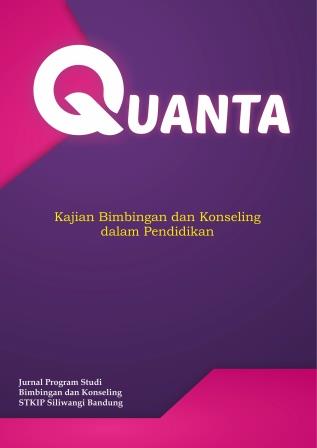The Influence of Information Services Using Video Media on the Career Selection of Junior High School Students
DOI:
https://doi.org/10.22460/quanta.v9i1.5535Keywords:
Career Selection, Video media, Informasi services, StudentsAbstract
This study aims to explore the effectiveness of video media in providing information that can influence learners' career decisions, which in turn can improve their understanding of the world of work and guide them toward more appropriate and realistic career choices. The study was conducted at SMP Negeri 34 Semarang in 2023. This research used a quasi-experimental design with a nonequivalent control group design model. The data collection technique used was a questionnaire of students' career choices, and data analysis was done using descriptive statistics. The analysis showed that the F-count value was 5.333 with a significance level of 0.036 <0.05, so information services with video media affected the career selection of third-grade students at SMP Negeri 34 Semarang. The study's conclusion reveals that information services with video media affect the career selection of third-grade students at SMP Negeri 34 Semarang. The research contributes to the field of guidance and counseling, especially regarding the use of video media as an effective information tool in helping students understand career choices.References
Anisa, R. N. (2022). Efektivitas Layanan Bimbingan Klasikal Dengan Teknik PJBL Untuk Meningkatkan Pemahaman Pilihan Karir Siswa Tunarungu Kelas IX. COMSERVA: Jurnal Penelitian Dan Pengabdian Masyarakat, 2(7), 995-1011. https://doi.org/10.59141/comserva.v2i7.453
Beaumont, E., Gedye, S., & Richardson, S. (2016). ‘Am I employable?’: Understanding students' employability confidence and their perceived barriers to gaining employment. Journal of Hospitality, Leisure, Sport & Tourism Education, 19, 1-9. https://doi.org/10.1016/j.jhlste.2016.06.001
Dwivedi, Y. K., Hughes, D. L., Coombs, C., Constantiou, I., Duan, Y., Edwards, J. S., ... & Upadhyay, N. (2020). Impact of COVID-19 pandemic on information management research and practice: Transforming education, work and life. International journal of information management, 55, 102211. https://doi.org/10.1016/j.ijinfomgt.2020.102211
Farhan, F., & Biran, M. (2022). Perspektif teori holland dalam pemilihan karir siswa SMA di era teknologi informasi. Jurnal EDUCATIO: Jurnal Pendidikan Indonesia, 8(1), 9-13. http://dx.doi.org/10.29210/1202221148
Fikriyani, D. N., Nurbaeti, N., & Hidayat, D. R. (2020). Pemilihan Karir Berdasarkan Kepribadian Pada Siswa. Jurnal Ilmiah Bimbingan Konseling Undiksha, 11(1), 21-30. https://doi.org/10.23887/jjbk.v11i1.27348
Gan, B., Menkhoff, T., & Smith, R. (2015). Enhancing students’ learning process through interactive digital media: New opportunities for collaborative learning. Computers in Human Behavior, 51, 652-663. https://doi.org/10.1016/j.chb.2014.12.048
Ikhsan, I., Dharmayana, I. W., & Sholihah, A. (2019). Pengaruh layanan informasi dengan menggunakan media video terhadap pemahaman perilaku perundungan siswa di smp negeri 17 kota bengkulu. Consilia: Jurnal Ilmiah Bimbingan dan Konseling, 2(3), 236-244. https://doi.org/10.33369/consilia.2.3.236-244
Jannah, S. R., Irhamni, G., & Fauzi, Z. (2020). Peran Guru BK Dengan Layanan Informasi Dalam Mengatasi Kenakalan Remaja Bagi Siswa Kelas X Di SMK Tunas Bangsa. Jurnal Bimbingan Dan Konseling Ar-Rahman, 6(2), 99-103. http://dx.doi.org/10.31602/jbkr.v6i2.2523
Lei, P. L., Sun, C. T., Lin, S. S., & Huang, T. K. (2015). Effect of metacognitive strategies and verbal-imagery cognitive style on biology-based video search and learning performance. Computers & Education, 87, 326-339. https://doi.org/10.1016/j.compedu.2015.07.004
Lent, R. W., & Brown, S. D. (2019). Social cognitive career theory at 25: Empirical status of the interest, choice, and performance models. Journal of Vocational Behavior, 115, 103316. https://doi.org/10.1016/j.jvb.2019.06.004
Lent, R. W., & Brown, S. D. (2020). Career decision making, fast and slow: Toward an integrative model of intervention for sustainable career choice. Journal of Vocational Behavior, 120, 103448. https://doi.org/10.1016/j.jvb.2020.103448
Lent, R. W., Ireland, G. W., Penn, L. T., Morris, T. R., & Sappington, R. (2017). Sources of self-efficacy and outcome expectations for career exploration and decision-making: A test of the social cognitive model of career self-management. Journal of vocational behavior, 99, 107-117. https://doi.org/10.1016/j.jvb.2017.01.002
Muttaqin, R., Wagimin, W., & Tadjri, I. (2017). Keefektifan layanan informasi karier berbantuan video interaktif dan live modeling untuk meningkatkan pemahaman karier siswa SMP. Jurnal Bimbingan Konseling, 6(2), 174-179. https://journal.unnes.ac.id/sju/jubk/article/view/21794
Muttaqin, R., Wagimin, W., & Tadjri, I. (2017). Keefektifan layanan informasi karier berbantuan video interaktif dan live modeling untuk meningkatkan pemahaman karier siswa SMP. Jurnal Bimbingan Konseling, 6(2), 174-179. https://journal.unnes.ac.id/sju/jubk/article/view/21794
Muzdallifah, P. I., Suarti, N. K. A., & Rayani, D. (2022). Pengaruh layanan informasi karir terhadap self efficacy pada siswa kelas XI SMKN 3 Mataram. Realita: Jurnal Bimbingan dan Konseling, 7(2), 1759-1773. https://doi.org/10.33394/realita.v7i2.6222
Nufus, A. (2017). Faktor penentu pemilihan karir siswa SMK Negeri 1 Dukuhturi Kabupaten Tegal. Jurnal Riset Mahasiswa Bimbingan Dan Konseling, 3(3), 326-336. https://journal.student.uny.ac.id/index.php/fipbk/article/view/6554
Richiţeanu-Năstase, E. R., & Stăiculescu, C. (2015). The impact of career factors on students professional insertion. What measures to be taken by the university?. Procedia-Social and Behavioral Sciences, 180, 1102-1108. https://doi.org/10.1016/j.sbspro.2015.02.216
Safitri, E., Kiswantoro, A., & Zamroni, E. (2020). Meningkatkan Kematangan Pemilihan Karir Melalui Bimbingan Kelompok Dengan Teknik Problem Solving. Jurnal Prakarsa Paedagogia, 3(1). https://doi.org/10.24176/jpp.v3i1.5151
Syahroni, M. I. (2022). Prosedur penelitian kuantitatif. Jurnal Al-Musthafa STIT Al-Aziziyah Lombok Barat, 2(3), 43-56. https://scholar.archive.org/work/yxmnfakwpne4rnpbb2rrrognoe/access/wayback/https://ejurnal.stitaziziyah.ac.id/index.php/ejam/article/download/50/45
Tanjung, R. F., Neviyarni, N., & Firman, F. (2018). Layanan informasi dalam peningkatan keterampilan belajar mahasiswa stkip pgri sumatera barat. Jurnal Penelitian Bimbingan dan Konseling, 3(2). https://dx.doi.org/10.30870/jpbk.v3i2.3937
Torres-Ramírez, M., García-Domingo, B., Aguilera, J., & De La Casa, J. (2014). Video-sharing educational tool applied to the teaching in renewable energy subjects. Computers & Education, 73, 160-177. https://doi.org/10.1016/j.compedu.2013.12.014
Volodina, A., & Nagy, G. (2016). Vocational choices in adolescence: The role of gender, school achievement, self-concepts, and vocational interests. Journal of Vocational Behavior, 95, 58-73. https://doi.org/10.1016/j.jvb.2016.07.005
Woods, S. A., Edmonds, G. W., Hampson, S. E., & Lievens, F. (2020). How our work influences who we are: Testing a theory of vocational and personality development over fifty years. Journal of Research in Personality, 85, 103930. https://doi.org/10.1016/j.jrp.2020.103930
Zacher, H., Rudolph, C. W., Todorovic, T., & Ammann, D. (2019). Academic career development: A review and research agenda. Journal of Vocational Behavior, 110, 357-373. https://doi.org/10.1016/j.jvb.2018.08.006
Downloads
Published
How to Cite
Issue
Section
License
Copyright (c) 2025 Rina Fatimah, Yovitha Yuliejantiningsih, Ismah Ismah

This work is licensed under a Creative Commons Attribution-ShareAlike 4.0 International License.
The author is responsible for acquiring the permission(s) to reproduce any copyrighted figures, tables, data, or text that are being used in the submitted paper. Authors should note that text quotations of more than 250 words from a published or copyrighted work will require a grant of permission from the original publisher to reprint. The written permission letter(s) must be submitted together with the manuscript.












